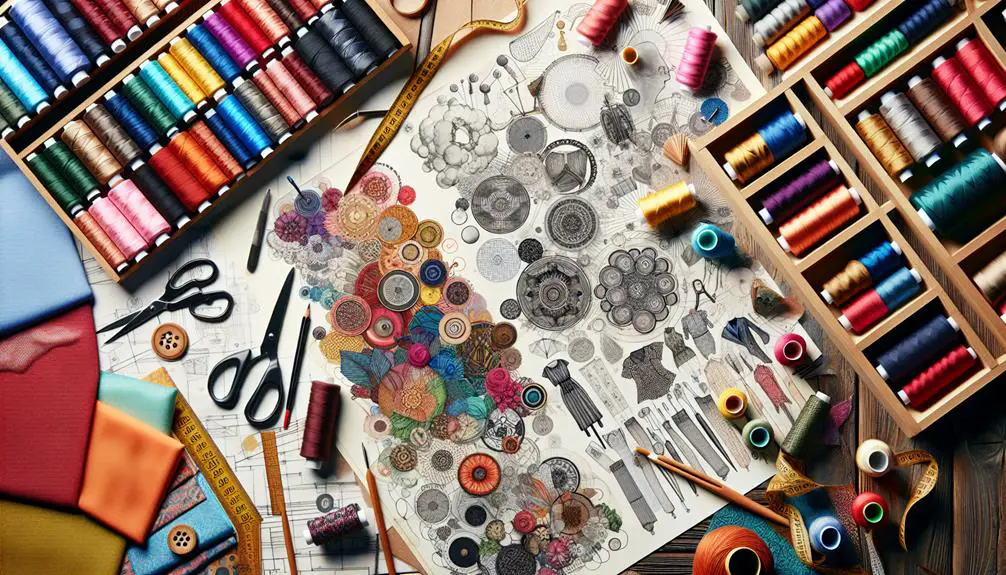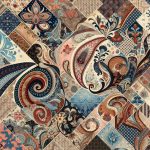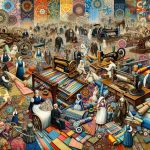When you think about the world of fabric design, it's impossible to ignore the trailblazing work of individuals like William Morris and Zandra Rhodes. These designers didn't just create patterns; they transformed textiles into art. Morris brought nature to life with his intricate motifs, while Rhodes turned heads with her rebellious, bold prints. But what about the unspoken legacy of Mariano Fortuny's dyeing methods or Kaffe Fassett's vibrant color palettes? As you explore their groundbreaking techniques, you'll find that the impact of these pioneers goes far beyond mere aesthetics. So, what makes their contributions so enduring and influential?
Table of Contents
Key Takeaways
- William Morris emphasized nature's intricate beauty in fabric design, making fabrics a narrative canvas.
- Mariano Fortuny combined ancient dyeing techniques with modern technology, influencing lasting textile design.
- Zandra Rhodes is celebrated for her bold prints and vibrant colors, challenging fashion conventions.
- Kaffe Fassett redefined fabric design with vibrant color blends and sustainable textile practices.
- Iris Van Herpen fuses fashion with technology, incorporating 3D printing and unconventional materials in her designs.
William Morris
When you think of influential fabric designers, William Morris unquestionably stands out for his innovative contributions to the Arts and Crafts Movement. His work wasn't just about creating beautiful textiles; it was about infusing everyday objects with artistic inspiration and a sense of craftsmanship that had been lost during the Industrial Revolution.
Morris believed that fabric design should reflect nature's intricate beauty, and his decorative motifs often featured detailed representations of flowers, leaves, and birds.
To truly appreciate Morris's genius, you need to explore into his philosophy. He saw fabric as a canvas for storytelling, filled with rich, natural patterns that brought a sense of peace and harmony into homes. His designs weren't merely decorative; they were carefully crafted to evoke emotional responses and connect people more deeply with their surroundings.
You'll notice that in Morris's work, each decorative motif serves a purpose. These elements aren't randomly placed but thoughtfully arranged to create a cohesive and aesthetically pleasing narrative.
Mariano Fortuny
You'll find Mariano Fortuny's impact on fabric design astonishing, especially his unique dyeing techniques.
His timeless textile patterns continue to inspire modern designers.
Let's explore how his innovations have shaped contemporary design.
Unique Dyeing Techniques
Mariano Fortuny revolutionized fabric design with his innovative dyeing techniques that combined ancient methods with modern technology. You'll find his approach fascinating, as it's a perfect blend of tradition and modernity.
Fortuny's Shibori experimentation brought a new dimension to fabric art. By adapting this Japanese technique, which involves folding, twisting, or bunching cloth and binding it before dyeing, he created intricate patterns and textures that were both novel and timeless.
Fortuny didn't stop there. He led a Batik revival, breathing new life into this ancient Indonesian dyeing method. By applying wax to fabric before dyeing, he achieved stunning, multi-layered designs that captivated the fashion world. His meticulous process guaranteed that each piece was a unique work of art, reflecting a rich cultural heritage while pushing the boundaries of contemporary design.
You can see Fortuny's mastery in every detail. His ability to seamlessly integrate these techniques into his fabrics showed his deep understanding of both the historical significance and the practical applications of dyeing.
Timeless Textile Patterns
Fortuny's innovative dyeing techniques laid the foundation for his timeless textile patterns that continue to inspire designers today. His fabrics are renowned for their intricate designs and lasting appeal, blending cultural symbolism with traditional textile motifs.
You can see how his meticulous approach to fabric creation has made his work a benchmark in textile preservation techniques and historic fabric safeguarding.
- Textile preservation techniques: Fortuny's commitment to quality guarantees his patterns remain vibrant and intact over time, making them ideal subjects for safeguarding.
- Cultural representation: His designs often incorporate motifs from various cultures, adding layers of meaning and historical significance to each piece.
- Traditional fabric patterns: Fortuny masterfully revived ancient designs, giving them new life and relevance in contemporary design.
Influence on Modern Design
How has Fortuny's genius influenced modern design in ways that still resonate today?
You can see his impact in the innovative approaches designers use to marry tradition with technology.
Fortuny's meticulous craftsmanship and attention to detail laid the groundwork for what you now recognize as sustainable fabric practices. He was ahead of his time, valuing quality and longevity over mass production, which aligns seamlessly with today's sustainability ethos.
You also can't overlook Fortuny's pioneering use of technology. While he didn't have access to modern digital printing techniques, his experimental spirit paved the way for their development.
Today's designers leverage digital printing to create intricate patterns, much like Fortuny did with his patented methods. This technology allows for precision and customization, qualities Fortuny would have championed.
Moreover, Fortuny's designs continue to inspire the aesthetic choices you see in contemporary interiors and fashion. His blending of historical motifs with modern sensibilities speaks directly to today's trend of fusing the old with the new.
Zandra Rhodes
Renowned for her bold prints and vibrant colors, Zandra Rhodes has redefined the world of textile design. Her fearless use of bold color palettes and avant-garde designs has set her apart as a true innovator. You can't help but be captivated by her ability to blend daring hues with intricate patterns, creating textiles that are as much a statement as they're fabric.
Zandra's journey in textile innovation is marked by her numerous artistic collaborations, which have pushed the boundaries of what fabric can be. Whether working with fashion houses or cultural institutions, she brings a unique vision that transforms textiles into wearable art. Her work isn't just about creating beautiful fabrics; it's about challenging conventions and inspiring a new generation of designers.
To truly appreciate Zandra Rhodes' contributions, consider the following:
- Iconic Designs: Many of her prints have become timeless classics in the fashion world.
- Cultural Impact: Her work is celebrated in museums and fashion shows globally.
- Educational Influence: She continues to mentor young designers, ensuring her legacy endures.
Embrace the bold and the beautiful with Zandra Rhodes, a true pioneer in textile design.
Kaffe Fassett
When you explore Kaffe Fassett's work, you'll immediately notice his mastery of colorful patterns that breathe life into textiles.
He's redefined textile art, pushing boundaries with his vibrant designs.
You're about to see how his innovative approach has influenced the evolution of fabric design.
Colorful Pattern Mastery
Few can rival Kaffe Fassett's unparalleled ability to blend vibrant colors into mesmerizing patterns. As someone seeking mastery in fabric design, you'll find his use of geometric shapes and vibrant colors particularly inspiring. Fassett's work isn't just about color; it's a tapestry of cultural influences and abstract designs that tell a story. His patterns are a visual feast that draw you in and challenge you to think beyond conventional boundaries.
- Geometric Shapes: Fassett's designs often incorporate bold geometric patterns, creating a dynamic interplay of shape and color.
- Vibrant Colors: His fearless use of color transforms simple designs into striking works of art that captivate the eye.
- Cultural Influences: Fassett pulls inspiration from a myriad of cultures, infusing his work with a rich tapestry of global aesthetics.
Mastering the art of vibrant color and pattern, like Fassett, requires an appreciation for the subtleties of color theory and an eye for detail. Study his work to understand how he balances bold hues with intricate patterns.
Let his innovative approach guide you in pushing the boundaries of your own designs, transforming fabric into a canvas of endless possibilities.
Textile Art Evolution
Kaffe Fassett's journey in textile art redefined how we perceive fabric design. By mastering textile color theory, he transformed simple threads into vivid tapestries that tell compelling stories. You can see his genius in the way he blends hues, creating a harmonious yet dynamic visual experience. Fassett's keen understanding of fabric manipulation techniques allows you to appreciate the intricate textures and patterns he crafts, each one a proof to his innovative approach.
Cultural influences play a significant role in Fassett's work. Drawing inspiration from diverse traditions, he seamlessly integrates motifs from various cultures, giving his designs a rich, global narrative. When you examine his pieces, you'll notice the subtle nods to different art forms and histories, making each creation a multicultural tapestry.
Sustainable textile practices are another cornerstone of Fassett's philosophy. He encourages the use of eco-friendly materials and methods, ensuring that his artistry doesn't come at the expense of our planet. By prioritizing sustainability, Fassett sets a standard for responsible creativity, demonstrating that you can achieve artistic excellence without sacrificing environmental integrity.
In essence, Kaffe Fassett's textile art evolution is a masterclass in combining theory, technique, cultural richness, and sustainability.
Vera Neumann
Vera Neumann revolutionized fabric design with her bold, colorful patterns that captured the essence of mid-20th-century style. Her work wasn't just about aesthetics; it was about creating pieces that resonated with everyday life. Neumann's designs, often inspired by nature and abstract artistry, brought a fresh perspective to the world of textiles.
- Vibrant color palettes
- Nature-inspired motifs
- Versatile applications
You're likely familiar with her iconic scarves, which became a symbol of sophistication and artistic flair. These pieces were more than just accessories; they were wearable art that showcased her ability to blend abstract artistry with functional design. Each scarf was a canvas, displaying her distinct use of color and form.
Neumann's contributions went beyond just scarves. She extended her design prowess to home décor, including linens and wall art, ensuring her work touched various aspects of daily life. Her approach made art accessible, allowing people to integrate beauty and creativity into their homes effortlessly.
Alexander McQueen
Alexander McQueen, renowned for his groundbreaking designs and theatrical runway presentations, redefined the fashion landscape with his innovative approach to fabric and form. He didn't just create clothes; he crafted experiences. His runway creations were nothing short of spectacular, often blending the macabre with the sublime. McQueen's distinctive vision turned each show into a narrative, capturing the imagination of audiences worldwide.
You can see his genius in the way he manipulated fabrics. He wasn't afraid to experiment, often using unconventional materials to create avant-garde fashion that defied traditional norms. His use of intricate embroidery, digital prints, and unexpected textures set new standards in the industry. Each piece was a testament to his meticulous craftsmanship and keen eye for detail.
McQueen's work wasn't just about aesthetics; it was a bold commentary on society, culture, and identity. He challenged conventions and pushed the boundaries of what fashion could be. By embracing both the beautiful and the grotesque, he made you question your perceptions and think beyond the ordinary. In doing so, Alexander McQueen left an indelible mark on the world of fashion, forever altering its course.
Iris Van Herpen
Iris Van Herpen, a trailblazer in the fusion of fashion and technology, continually pushes the envelope with her cutting-edge designs. You're likely captivated by her avant-garde fashion, which seamlessly integrates technology to create wearable art that challenges traditional boundaries. Her expertise lies in melding intricate craftsmanship with innovative techniques, making each piece a tribute to her visionary approach.
Van Herpen's work stands out for several reasons:
- 3D Printing: She was one of the first designers to incorporate 3D printing into her collections, revolutionizing the fashion landscape.
- Material Experimentation: She uses unconventional materials like silicone, magnets, and even glass to craft garments that defy the ordinary.
- Collaborative Efforts: Van Herpen collaborates with engineers, architects, and artists, enriching her designs with multidisciplinary insights.
Her collections are a celebration of the symbiosis between nature and technology. Van Herpen's commitment to technology integration doesn't just stop at aesthetics; it transforms how we think about fabric and form.
If you're aiming for mastery in fashion design, studying her pioneering methods will offer invaluable insights into pushing your creative boundaries.
Frequently Asked Questions
What Are Common Techniques Used in Fabric Design?
When designing fabric, you'll use color theory and textile printing techniques. Master pattern creation by experimenting with surface embellishment techniques like embroidery and beading. These methods elevate your designs, offering unique, sophisticated results.
How Do Fabric Designers Choose Their Materials?
In the fabric selection process, you'll draw from creative inspiration and consider factors like texture, durability, and color. Designers analyze trends, sustainability, and functionality to guarantee the material aligns with their vision and project requirements.
What Role Does Technology Play in Modern Fabric Design?
Imagine creating a stunning dress using digital printing and 3D modeling. Technology lets you experiment with intricate designs and precise patterns, ultimately elevating your fabric design skills and achieving mastery in the modern textile industry.
How Do Cultural Influences Shape Fabric Design Trends?
Cultural influences and historical context shape fabric design trends by infusing traditional patterns, symbols, and colors into contemporary styles. You'll see designers draw inspiration from heritage, creating pieces that resonate with cultural significance and modern appeal.
What Are the Environmental Impacts of Textile Production?
Just as Pandora's box released chaos, textile production greatly impacts the environment. You're dealing with water pollution, high energy consumption, waste disposal issues, and greenhouse gas emissions. Addressing these is vital for sustainable fashion.
- What Is Pochampally Ikat? a Journey to India’s Silk City - June 27, 2025
- What Is Pochampally Ikat? a Journey to India’s Silk City - June 27, 2025
- What Is Pochampally Ikat? a Journey to India’s Silk City - June 27, 2025







